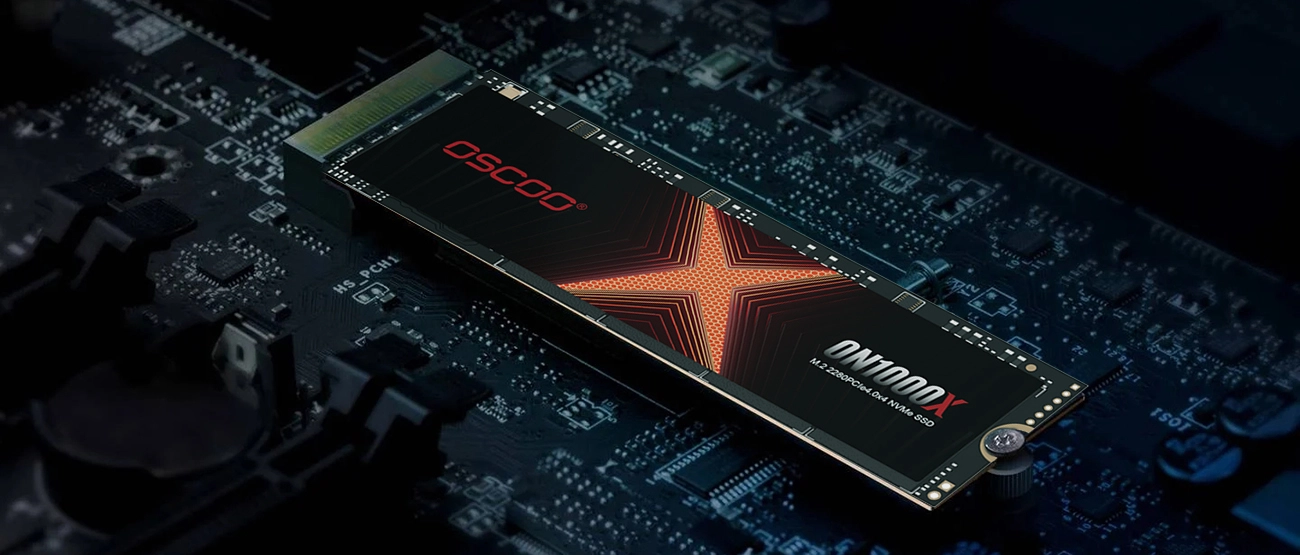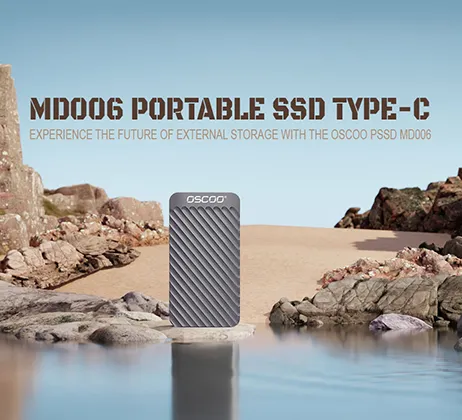If your computer starts up slowly, programs take too long to load, or file transfers get stuck, the traditional mechanical hard drive (HDD) is likely the bottleneck. Solid State Drives (SSDs) solved the speed problem and have become standard in modern computers. However, SSDs using the SATA interface still face a speed limit due to that interface itself. To achieve even faster speeds and a more compact form, M.2 SSDs were developed. They are very thin and overcome the SATA speed barrier. So, how exactly do M.2 SSDs achieve this leap in speed? What are the key differences between them and traditional SSDs? This guide will explain everything you need to know about this core modern storage technology.
What is an M.2 SSD?
An M.2 SSD is a new type of solid-state drive. It is completely different from the common 2.5-inch SATA SSDs or traditional mechanical hard drives which require separate power and data cables. An M.2 SSD looks like a long, thin circuit board, typically not much larger than a stick of gum.
An M.2 SSD does not need separate power or data cables. Instead, it plugs directly into a dedicated slot on your computer’s motherboard using gold-plated connectors along its bottom edge. This design avoids messy cables, keeping the inside of your computer case clean and tidy.
The most important value of an M.2 SSD is its ability to bypass the limitations of the traditional SATA interface. Even a good SATA SSD has a maximum theoretical speed of around 600MB/s. By connecting directly to the motherboard’s high-speed channels, M.2 SSDs have the potential to reach speeds far beyond this limit.
A typical M.2 SSD consists of several key parts: NAND flash memory chips for storing data, a controller chip for managing and transferring data, and sometimes a separate DRAM cache chip for better performance. All these components are mounted onto a small printed circuit board (PCB).
In summary, M.2 SSDs offer the potential to break through SATA speed limits. They achieve this through their small, card-like design that plugs directly into the motherboard. Their key characteristics are smaller size, higher data transfer potential, and simpler installation.
Why You Need an M.2 SSD?
M.2 SSDs aren’t just a trend. They provide real performance benefits in many practical situations.
- High-performance desktops: If you’re building or upgrading a high-performance desktop PC, installing your operating system (like Windows) on an M.2 SSD as the system drive is a smart choice. This brings immediate improvements: significantly faster boot times, allowing you to go from pressing the power button to the desktop in seconds. Everyday tasks like launching applications also become much quicker, with large browsers or office software opening almost instantly, reducing frustrating waits.
- Laptop users: For laptop users prioritizing portability, M.2 SSDs are especially advantageous. Traditional hard drives and 2.5-inch SSDs take up valuable internal space. The compact size of M.2 SSDs fits perfectly within the tight confines of thin and light laptops. Crucially, they allow laptops to achieve storage speeds close to high-end desktops, improving overall system responsiveness.
- Gamers: For gamers, modern games are huge. Loading scenes, high-resolution textures, and large open-world maps demand high drive speeds. Installing games on a high-performance M2 SSD dramatically reduces loading times, getting you into the action faster. More importantly, it greatly improves real-time loading during gameplay. This minimizes issues like stuttering, texture pop-in, or delayed model loading when moving quickly or driving vehicles, creating a smoother, more seamless game world. This is especially beneficial in games supporting newer technologies like DirectStorage.
- Creative professionals: Professionals or enthusiasts working with video editing, photo retouching, 3D rendering, or music production often handle large high-resolution source files, easily reaching several gigabytes or even tens of gigabytes. Transferring these large files is time-consuming. Editing tasks like loading/saving project files, applying complex effects, and multi-track previewing place heavy demands on storage performance. Using a fast M2 SSD as your working drive can multiply file transfer speeds, cut down import times for source materials, and provide faster responsiveness and rendering during editing, significantly boosting productivity.
- Compact devices: Finally, for compact devices like Home Theater PCs or mini PCs with extremely limited space, M2 SSDs are often the only solution providing high-performance storage within a small footprint. They ensure these devices stay slim while delivering the core speed needed for entertainment centers or compact office setups.
In short, if you need faster computer response for booting and launching software, a smoother gaming experience, more efficient workflows, or high performance in space-constrained devices, an M2 SSD is the preferred solution.
The Secret of Speed: Interface, Protocol, and Lanes
Understanding the speed differences of M2 SSDs requires grasping three interconnected concepts: the physical interface, the transfer protocol, and the data lanes they use. These factors together determine how data flows quickly between the M2 SSD, the motherboard, and the CPU.
First, all M2 SSDs use the M2 physical interface to connect to the motherboard. This interface is a standardized connector shape, but it doesn’t dictate speed. The real performance difference comes from the type of data lane used behind this interface. There are two main types:
- SATA Lanes: This is the older transfer method. An M2 SSD using SATA lanes works exactly like a regular 2.5-inch SATA SSD. It remains limited by the SATA speed bottleneck, with a maximum theoretical speed of around 600MB/s. While much faster than an HDD, this doesn’t fully utilize the M2 form factor‘s potential.
- PCI Express Lanes (PCIe): This is the key to unlocking M2 SSD speed. PCIe is the motherboard’s high-speed data highway, typically used for powerful devices like graphics cards. Modern motherboards often connect their M2 slots directly to PCIe lanes provided by the CPU. These lanes offer much wider “data bandwidth” than SATA, allowing M2 SSDs to potentially reach speeds far exceeding SATA limits.
Using a high-speed lane isn’t enough. Efficient data management rules are also needed, which is the role of the transfer protocol.
- AHCI Protocol: This is an older protocol designed primarily for spinning hard drives and early SATA SSDs. It can also be used on M2 SSDs that utilize SATA lanes. AHCI is relatively inefficient at handling the large number of simultaneous requests modern flash memory can generate.
- NVMe Protocol: Short for Non-Volatile Memory Express, this protocol is designed specifically for high-speed storage devices like SSDs. NVMe excels because it’s built for high concurrency and extremely low latency. It can much more effectively utilize the bandwidth of PCIe lanes. High-performance M.2 SSDs rely almost entirely on NVMe.
Now we see the combination for the M.2 SSD speed leap:
| Configuration | Components | Performance |
|---|---|---|
| Slow Combo | M.2 Interface + SATA Lanes + AHCI Protocol | Performance equal to a regular SATA SSD (~600MB/s). Just a neater installation. |
| Fast Combo | M.2 Interface + PCIe Lanes + NVMe Protocol | Huge performance leap! Read/write speeds easily surpass 2000MB/s, with high-end models reaching 7000MB/s or higher. |
Finally, pay attention to the PCIe Generation:
- PCIe 3.0 x4: Bandwidth ~4GB/s. Mature and widely supported.
- PCIe 4.0 x4: Bandwidth ~8GB/s. Twice as fast as PCIe 3.0, becoming the current mainstream for high performance.
- PCIe 5.0 x4: Bandwidth ~16GB/s. Doubles speed again, representing the future.
When buying an M.2 SSD for speed, focus on two core aspects: Does it use the NVMe protocol? And which PCIe version does it use? These are the key factors determining its performance potential.
Size Matters: Understanding the Numbers
 M.2 SSDs are small but not all the same size. They come in various physical formats to fit different device spaces. These formats are identified by a four-digit code, like the common 2280, 2242, or 22110. Understanding this code is crucial for choosing and installing the right drive.
M.2 SSDs are small but not all the same size. They come in various physical formats to fit different device spaces. These formats are identified by a four-digit code, like the common 2280, 2242, or 22110. Understanding this code is crucial for choosing and installing the right drive.
The four-digit code is simple: the first two digits represent the width, the last two digits represent the length. Both are in millimeters (mm).
| Size Code | 尺寸 | Usage | 兼容性 |
|---|---|---|---|
| 2280 | 22mm x 80mm | Absolute mainstream for consumers | Compatible with most desktops, gaming laptops, and thin-and-light laptops |
| 2242 | 22mm x 42mm | Space-constrained devices | Ultra-thin notebooks, compact desktops (Intel NUC), secondary slots |
| 2230 | 22mm x 30mm | Specific compact devices | Microsoft Surface models, Valve Steam Deck |
| 22110 | 22mm x 110mm | Extreme performance/capacity | High-end desktops, workstations, servers (rare in consumer devices) |
Before buying any M.2 SSD, consult your computer or motherboard’s user manual. Confirm the exact physical length the M.2 slot supports. For most users, the 2280 size is the one to focus on.
The Slot: Home for Your M.2 SSD
 For an M.2 SSD to work, it must be correctly installed into its designated slot on the motherboard, called the M.2 slot. Understanding this slot is important for proper installation.
For an M.2 SSD to work, it must be correctly installed into its designated slot on the motherboard, called the M.2 slot. Understanding this slot is important for proper installation.
First, find the M.2 slot’s location. On desktop motherboards, common locations are below the CPU socket or near the bottom PCIe x16 graphics card slot. Positions vary by model and manufacturer. High-end motherboards may offer two or three M.2 slots. In laptops or mini PCs, the M.2 slot is inside, usually requiring bottom cover removal.
Physically, the M.2 slot is a long, narrow metal socket. Inserting the SSD requires aligning the SSD’s gold-plated connectors with the slot’s metal contacts. To ensure correct orientation, both the slot and SSD have a special cutout design called a “Key”. Keys prevent incorrect insertion.Common Key types:
- B Key: This slot typically supports M.2 devices using SATA lanes or lower-bandwidth PCIe x2 lanes. Less common in modern high-performance systems..
- M Key: This is the dominant type. M Key slots support higher-bandwidth PCIe x4 lanes and are the standard for high-performance NVMe M.2 SSDs. When buying an NVMe SSD, ensure your motherboard’s slot is M Key.
- B & M Key: This slot has cutouts for both B and M Keys. Physically, it can accept both B Key and M Key SSDs. However, this doesn’t guarantee full high performance. A B&M Key slot might only support SATA, only support PCIe, or have limited functionality. Its performance ceiling might be lower than a pure M Key slot.
Another critical aspect is heat management. High-performance NVMe M.2 SSDs, especially PCIe 4.0 and 5.0 models, generate significant heat under load. Overheating forces the SSD to throttle its speed to protect itself, preventing sustained peak performance.
To combat this:
- Use motherboards with built-in M.2 heatsinks.
- Choose SSDs with integrated heatsinks.
- Install third-party M.2 heatsinks.
Always check the motherboard manual! It tells: Which slot is M Key (for high-speed NVMe)? what physical sizes (lengths) does the slot support? Does the slot connect to CPU lanes or chipset lanes? Does using it disable other ports (like some SATA ports)? Does the motherboard include a heatsink? Understanding these key slot details ensures your M.2 SSD has a suitable home where it can work stably and efficiently.
M2 SSD Pros and Cons
M2 SSD Advantages
- Outstanding Performance: NVMe PCIe models offer read/write speeds far exceeding traditional SATA SSDs. This revolutionizes system boot times, application loading, large file transfers, and complex tasks, making the computer feel noticeably faster and more responsive.
- Space Saving and Cleaner Builds: Mounting directly on the motherboard eliminates separate SATA data and power cables. This simplifies internal cable management, creates a cleaner look, and crucially saves valuable space in laptops and small form-factor PCs.
- Easier Installation: Installing an M.2 SSD is simple. The core steps are inserting the SSD at an angle into the slot, pressing it flat, and securing it with one screw. This generally requires just a screwdriver.
- Potential Power Efficiency: When handling data-intensive tasks, high-performance M.2 SSDs can be more efficient than SATA SSDs. Their speed allows them to finish tasks faster and enter low-power states quicker.
- Silent Operation: As a purely electronic device with no moving parts, M.2 SSDs produce no noise or physical vibration during operation.
M2 SSD Disadvantages
- Heat Generation: High performance inevitably leads to higher power consumption and heat. Top-tier NVMe M.2 SSDs, particularly current PCIe 4.0/5.0 models, generate substantial heat under load.
- Higher Cost Per Gigabyte: Comparing the cost per gigabyte of storage, high-performance M.2 NVMe SSDs (especially PCIe 4.0+) are typically more expensive than SATA SSDs, which are themselves more expensive than HDDs.
- Interface Matching Required: There is a “compatibility trap” with the M.2 interface. Some M.2 SSDs use SATA lanes and protocols, performing no better than standard SATA SSDs and not leveraging the M.2 form factor‘s potential. Buying such a drive by mistake leads to disappointment.
- Less Expansion Flexibility: Motherboards usually offer limited M.2 slots (commonly 1-3, 4+ on high-end boards). Once slots are filled, upgrading usually means replacing an existing drive or using an expansion card (like a PCIe to M.2 adapter)
- PCIe 5.0 Challenges: The latest PCIe 5.0 M.2 SSDs offer incredible speeds but face significant heat issues, high prices, and strict motherboard/CPU requirements.
Choosing Your M.2 SSD
Step 1: Check Your Motherboard Manual
- Physical size: What lengths does the slot support? 2280? 2242? 2230? 22110? Buying the wrong size prevents installation.
- Interface & protocol support: Does the slot support NVMe? Does it use PCIe lanes or only SATA lanes? If PCIe, which generation (3.0, 4.0, 5.0)? Does it support x4 lanes? This dictates the performance level you can use.
- Cooling solutions: Does the motherboard have a heatsink installed over the M.2 slot? Critical for high-performance drives.
Step 2: Define Your Needs
- System Drive: Speed is critical. Prioritize NVMe PCIe SSD. Start at 250GB, but 500GB or 1TB is recommended.
- Game/Application Drive: Requires NVMe PCIe speed. 1TB or 2TB is suitable.
- Storage Drive: Consider SATA SSDs or mid-tier NVMe SSDs. For tight budgets, larger SATA SSDs or HDDs might be more cost-effective.
Step 3: Focus on Key Specs (For NVMe PCIe SSDs)
- Protocol & Interface: Must be NVMe PCIe. Avoid SATA-based M.2 SSDs unless budget/requirements demand it.
- PCIe Generation: PCIe 4.0 offers the best balance of speed and maturity today
- RSequential Read/Write Speeds: Higher is better.
- Random Read/Write Performance (IOPS): Higher is better.
- Capacity: Choose the right capacity according to your need and budget.
- NAND Type & Layers: TLC balances performance/endurance. QLC is Cheaper per GB, but with lower write speeds and endurance than TLC.
- TBW (Terabytes Written): Manufacturer’s endurance rating. Higher is better.
- DRAM Cache: Models with dedicated DRAM cache typically offer more stable performance. High-end models usually include it.
- Brand & Warranty: Choose reputable brands with reliable support. Look for warranty length (typically 3-5 years), longer is better.
M.2 SSDs, particularly high-performance models using NVMe and PCIe, overcome SATA speed limits. They significantly improve boot times, loading speeds, and transfer operations, making computers much more responsive. Their compact size saves space, and installation is relatively simple. M.2 SSDs are the preferred choice for high-speed storage in modern computers.




